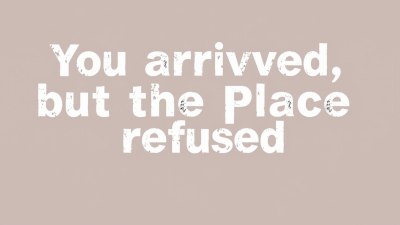You Arrived, but the Place Refused
Explore the themes of acceptance and rejection in personal and societal contexts.

Image created with Flux Schnell
In a world that often prioritizes appearances over genuine connections, the phrase 'You arrived, but the place refused' resonates deeply within us. It speaks to the innate human desire for belonging, acceptance, and understanding, while simultaneously highlighting the harsh realities of rejection that many face in various aspects of life.
Throughout history, the struggle to find one's place has taken shape in many forms, from communities rejecting individuals based on their identities, to personal relationships fraught with misunderstanding. This dichotomy of arrival and refusal invites reflection on what it means to be truly welcome—a question that is as relevant today as it has ever been.
The Journey of Arrival
The act of arriving signifies many things: a destination reached, a new chapter begun, or an opportunity for growth. Yet, this journey can often be fraught with challenges. The anticipation of arrival is often filled with hope, excitement, and the prospect of new beginnings. However, it is essential to recognize that not all arrivals are met with open arms. As individuals navigate the complexities of acceptance within social frameworks, they may encounter barriers that prevent true integration.
For many, the journey towards acceptance begins with self-discovery. Understanding oneself—one’s values, beliefs, and aspirations—is crucial to shaping personal identity. However, identity is not formed in isolation; it exists in relation to others. As such, the overarching societal norms and cultural expectations play a significant role in determining how individuals perceive their place within a community.
The Impact of Social Constructs
Society constructs various narratives around belonging, often influenced by race, gender, socioeconomic status, and other identity markers. These constructs can dictate who is granted entry into certain spaces and who is rendered invisible. Those who don’t fit neatly within the box created by societal standards may find themselves in a continuous loop of arrival and refusal, where they arrive at a place only to feel unwelcome.
These social barriers can be overt or covert—some communities actively resist change, while others unknowingly perpetuate exclusion through microaggressions or biases. The result is a cycle where individuals either suppress their true selves to fit in or become disillusioned, embittered by the lack of acceptance, ultimately leading to self-isolation.
Personal Narratives of Refusal
The personal stories of rejection are vast and varied. There are countless narratives of individuals who faced exclusion based on their sexual orientation, ethnicity, or beliefs. Each story reflects a unique journey of resilience amid struggle. One exceptional tale is that of a young artist who moved to a new city, filled with dreams of showcasing her work. However, despite her talent, she was often met with closed doors, being told that her style didn’t fit the local aesthetic. This refusal fueled her determination, leading her to create an underground art movement that celebrated diversity and inclusion. Through collaboration and creativity, she transformed her rejection into a rallying cry for those who felt similarly outcast.
Similarly, the story of a refugee family reveals poignant insights into arrival and acceptance. After fleeing conflict, they arrived in a new country hoping for a fresh start. However, the hostility and suspicion they encountered often forced them to reconsider what it meant to belong. Despite these challenges, they forged ahead, creating connections within their new community. Their journey underscores the importance of empathy, as those who might initially refuse can often change through understanding and exposure to diverse experiences.
Breaking the Cycle of Refusal
To navigate the complexities of acceptance and rejection, proactive measures are critical. Communities must strive to dismantle barriers that perpetuate exclusion. This involves both individual and collective efforts to foster inclusivity. Practicing empathy, challenging biases, and actively seeking out diverse voices within any space is important for creating a welcoming environment. Educational initiatives play a vital role in reshaping perceptions and dismantling stereotypes, leading to broader acceptance.
Moreover, storytelling holds transformative potential. Sharing narratives of rejection and acceptance can humanize experiences and cultivate understanding. By amplifying the voices of those who have faced refusal, society can confront uncomfortable truths that prompt reflection and dialogue. This process can encourage communities to become more inclusive and empathetic, ultimately leading to a richer, more vibrant social tapestry.
The Role of Forgiveness
In the wake of rejection, forgiveness emerges as a powerful tool. For those who have faced refusal, the journey toward healing often requires letting go of resentment. This is not to say that the pain of rejection should be minimized; rather, understanding that forgiveness can free individuals to embrace their identities without the heavy burden of past hurts is crucial. It allows for personal growth and opens the door to new relationships that may offer acceptance.
Equally important is the need for communities to practice forgiveness. Acknowledging past wrongdoings and striving for reparative actions can help bridge gaps of understanding. When communities admit their failings and actively seek to create more inclusive spaces, they pave the way for meaningful connections. It transforms places that once rejected individuals into safe harbors that embrace diversity.
Weaving Together Acceptance
As individuals and communities work to reject the cycle of arrival and refusal, there is potential to create a tapestry of acceptance that resonates far beyond personal experiences. By embracing diversity, celebrating differences, and fostering genuine connections, society can cultivate environments where all individuals feel seen, heard, and valued. Ultimately, the goal is to turn 'you arrived, but the place refused' into 'you arrived, and the place embraced you.' This transformative journey is one that requires collective effort, introspection, and the unwavering belief that everyone deserves a seat at the table.
In conclusion, the journey of life is often marked by a series of arrivals and refusals—a reflection of our shared humanity. Each story of rejection offers an opportunity for growth, urging us to reflect on our own experiences while inspiring change within society. By prioritizing acceptance, compassion, and understanding, we can create a world where everyone feels at home.











